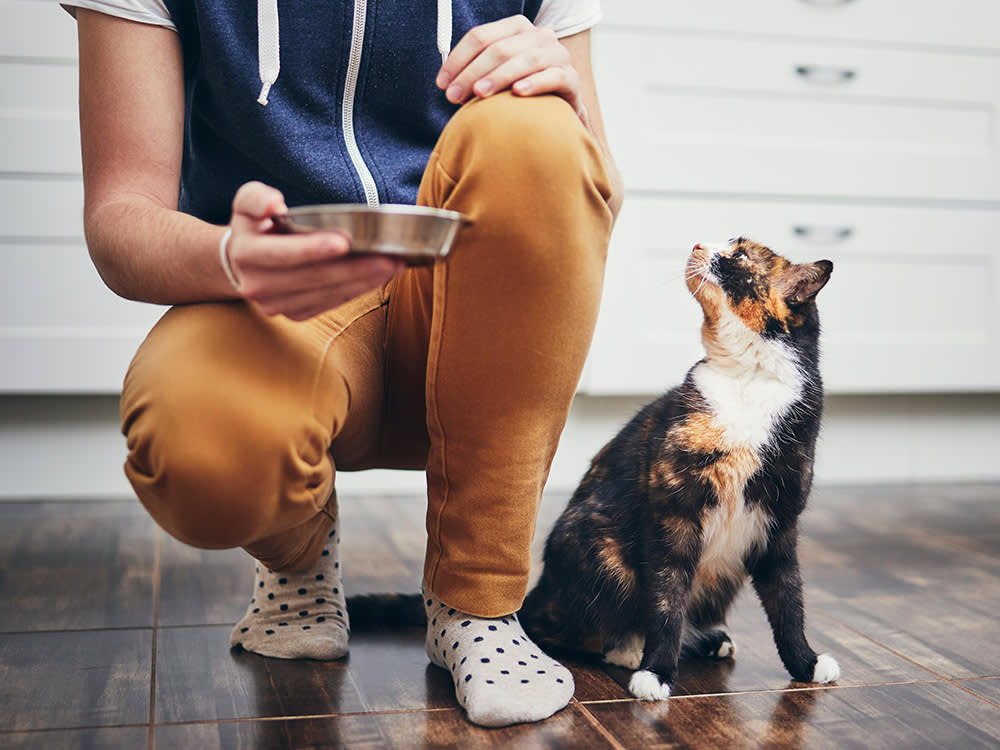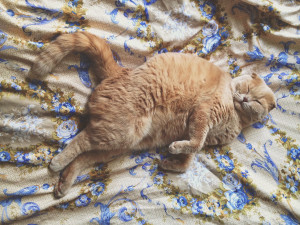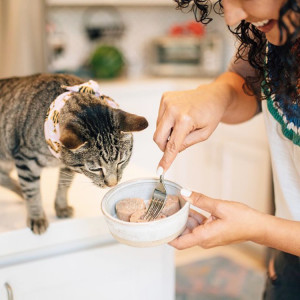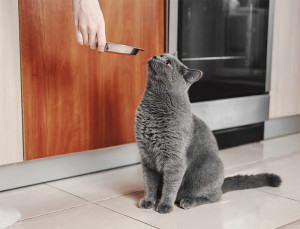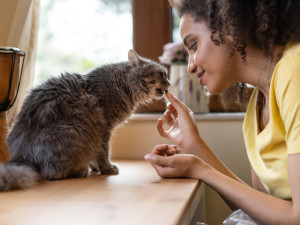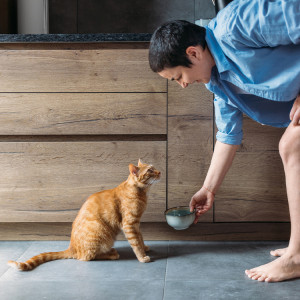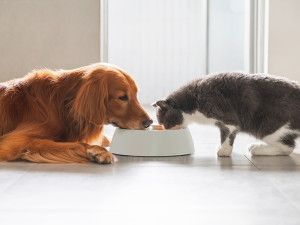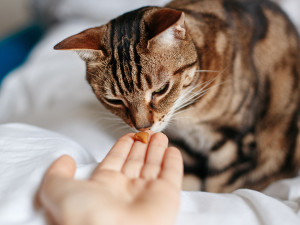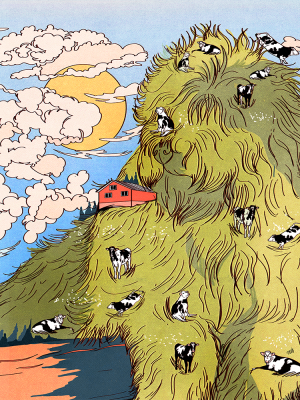What You Need to Know About High-Fiber Cat Food
Beyond your knowledge from old Fiber One commercials, here’s the full report on why your kitty might need fiber in their diet, too.
Fiber is a hot topic in the world of nutrition these days, with benefits ranging from improved gut health to enhancing the regularity of morning, er, constitutionals. So, you may be wondering if the same benefits hold true for your cat and which circumstances would warrant a high-fiber diet for cats. For starters, it is important to understand that fiber can be divided into two main categories: soluble and insoluble fiber,opens in new tab which serve different functions.
Insoluble fiber includes ingredients such as wheat bran or cellulose, which take up space within the digestive tract and lead to feelings of fullness. Soluble fiber, such as inulin, acts to draw water into the digestive tract, creating a gel-like substance that modifies digestion time. Some types of fiber in both categories also encourage fermentation that is actually good for all those important microbes in the gut. There are different situations where one of these kinds of fiber may be more beneficial than another, and some sources of fiber — such as psyllium husk — are a mix of both types.
Save on the litter with color-changing tech that helps you better care for your cat.
There are ways to be more confident about the amount of fiber your cat is consuming by using either a prescription diet that is high in a specific kind of fiber or by using a fiber supplement. Your reasons for increasing your cat’s fiber intake will determine which route you should go.
Why Would you Need to Feed a High-Fiber Diet to Your Cat?
The main reasons your cat might benefit from a high-fiber diet would be to help with conditions such as obesity, diabetes, or digestive tract problems, including hairballs or diarrhea. In each of these situations, fiber plays a different role in helping to treat a medical problem, so different kinds of fiber may be more useful in each case. As always, consult with your veterinarian to make sure you choose the right diet and that any other health problems are addressed at the same time.
How much do you spend on your pet per year?
High-Fiber Diets and Obesity in Cats
There are no short-cuts to weight loss in cats. The formula for weight loss can be oversimplified to taking in fewer calories while expending more calories on activity. Anyone who has ever tried to “take in fewer calories” knows that approach just leaves you feeling hangry. A hangry cat can also be a mischievous cat, unfortunately. Enter fiber, nature’s healthy filler food that can add bulk to the digestive tract, leading to feelings of fullness and satisfaction, even when the total calorie count of the meal is decreased.
Many cat foods aimed at weight lossopens in new tab, as well as those labeled specifically for indoor cats or less-active cats, use high-fiber ingredients to produce a food that is satisfying in a reasonable portion size with fewer calories. These diets often use a mix of soluble and insoluble fiber and may have other important variables, such as higher-protein contents, and/or lower total carbohydrates. It is also important to note that these diets are specially balanced to provide all of the important nutrients cats need in their daily diet, despite having fewer overall calories. It can be dangerous to limit your cat’s food intake without a special weight-loss food, both because they will be hungry all the time, and because giving smaller portions of a regular diet likely would not meet all of their nutritional needs.
High-Fiber Diets and Diabetic Cats
High-fiber diets for diabetics are a bit more complicated and controversial. In theory, fiber can play a role in regulating blood sugar by preventing extreme spikes or drops in blood glucose levels. At the same time, diabetic cats often benefit from high protein/low carbohydrate diets, sometimes referred to as the “Catkins Diet,” which also help to prevent spikes and drops in blood sugar. Some diets that are higher in fiber are also higher in carbohydrates, so it can be a trade-off as to which benefit is more important for a diabetic cat.
Often, it comes down to each individual cat and what other medical challenges they have, as well as which diets they prefer and will eat consistently. Most diabetic cats are also overweight or obese, and getting their weight down to a healthy range can have huge benefits in improving control of their diabetes and their overall health. Some cats may lose more weight with a higher-fiber diet, while others may do best on a high protein/low-carbohydrate diet, so it is important to consult with your vet in this case.
High-Fiber Diets and Digestive Tract Problems
In addition to specific therapies aimed at treating certain diseases, fiber can be beneficial in a variety of digestive tract conditions, including hairballs, inflammatory bowel disease (IBD), colitis, constipation, diarrhea, and anal sac impactions. These benefits stem from fiber’s ability to promote the health and growth of important microbes in the gut, to modify transit time of food through the digestive tract, and to add bulk to the poop while also making it softer.
Depending on the condition, different kinds of fiber in different combinations may be most effective. For conditions that affect the large bowelopens in new tab, or colon, of the digestive tract, including constipation, colitis and/or anal sac disease, insoluble fiber may be best. Diseases of the small intestine, such as IBD, might be most responsive to soluble fiber. Many of the prescription diets designed to treat these conditions will contain a specific kind of fiber in a quantity known to have beneficial effects.
Long-Term vs. Short-Term High-Fiber Diets
The answer to this question depends on why your cat needed a high-fiber diet in the first place. Some cats may benefit from a short-term high-fiber diet, if the goal is weight loss or to firm up soft poop or diarrhea caused by certain kinds of colitis or inflammation of the colon. In these cases, once those goals are achieved, a cat could be transitioned to another diet if your vet approves.
Your vet might recommend a long-term high-fiber diet if your cat has a chronic disease that needs to be managed forever, such as hairballs, chronic constipation, IBD, or recurrent anal sac impactions. Diabetic cats who are well-controlled on a high-fiber diet can remain on that diet long-term. Others may need to switch to a high-protein/low-carbohydrate diet if their diabetes is difficult to regulate. Any diet that will be used long-term needs to be balanced to meet all of a cat’s nutritional needs.
Important Factors to Keep in Mind
Fiber can be a very useful tool for treating many different conditions in cats as long as it is used properly and with guidance from a vet. Many high-fiber diets or supplements will increase the size of a cat’s poops, as well as their frequency, so be prepared to clean out the litter box more often and consider adding in an extra litter box to help prevent accidents.
Also, be aware that adding large amounts of fiber suddenly to the diet can lead to bloating and gas, which is uncomfortable and may temporarily decrease how much your cat wants to eat. For this reason, it is best to introduce fiber gradually so your cat has time to adjust. If you are considering a fiber supplement, make sure it is safe for cats and does not contain any ingredients that could be toxic to cats.
Also, make sure that the amount you are giving to your cat will not dilute other important nutrients from your cat’s diet if it leads to your cat feeling more full and eating less. When used properly with expert guidance, fiber can be a great tool for improving your cat’s health.
